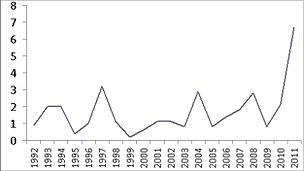Scottish field vole plague reaches record level
- Published
.jpg)
Field voles thrive under snow cover as it protects them from raptors
Scotland's recent freezing winters have resulted in a huge population explosion of field voles across the country.
Experts believe there are now record levels of the tiny mammals, which have been protected from birds of prey by long-lying snow.
Scientists in Dumfries and Galloway have recorded the highest number of field voles in 20 years, and a five-fold increase on average levels.
High levels have also been observed in central Scotland and the Highlands.
The number of field voles usually peaks every few years - known as a plague or outbreak - but this year has been exceptional in the south and west of Scotland, researchers have said.
Anecdotal and scientific evidence of the population explosion has been mapped by the BBC Scotland news website, external.
Aberdeen University professor of ecology Xavier Lambin said it was very difficult to work out the total number of field voles in Scotland, but that it could be in the region of 60 million.
This year the figure is potentially 10 times that, pushing their number into the hundreds of millions.

Voles caught per 100 traps in southern uplands, showing this year's peak. Data: Aberdeen Uni
Professor Lambin said: "They thrive under the snow. They tend to have a good year in these conditions.
"The snow provides thermal insulation, maintaining a temperature of 2-3C under the pack."
This protects the voles from the coldest temperatures and the cover stops them from being hunted by birds of prey like buzzards and owls, he said.
When the snow melts, a complex network of runs and tunnels is revealed in the grass in areas where there are high numbers of voles.
Receding snow cover makes them vulnerable to birds of prey, who now have a feast awaiting them.
Raptor experts report that buzzards and owls - which feed on field voles - are thriving this year.
George Swan, who is researching field voles in the Trossachs, said: "The brood size of tawny owls is one of the ways we measure field vole populations.
"This is how we know it's such a decent year because all the owl boxes in the Queen Elizabeth Forest Park have got four chicks in."
'Crazy' numbers
John Calladine, a senior research ecologist at the British Trust for Ornithology, said short-eared owls also appeared to be faring very well this year.
"In the few areas where people are looking at them carefully, last year was a good year and this year's looking good," he said.
"To have two good years in a row is unprecedented."
Another ecologist working for the Forestry Commission at Aberfoyle said there were "crazy" amounts of voles in the Loch Ard forest.
Many hillwalkers across Scotland have noticed the phenomenon, with anecdotal evidence, external of huge numbers of the voles in Muckart in Clackmannanshire, Knoydart, Glen Coe, Glen Shiel, and in the hills around Loch Earn and Loch Tay in Stirling.
Jamie Hageman, who was in the Sgurr nan Ceathreamhnan area, Glen Shiel, a few weeks ago, said he had never seen anything like it in his 20 years of hillwalking in Scotland.
"I was walking with my father and the lead person would scare them and then the person following would see them running away," he said.
"I pitched my tent on some runs and while I was packing it away, they were running underneath the groundsheet and hiding. They were quite tame."